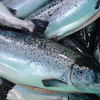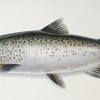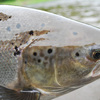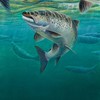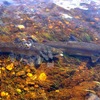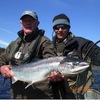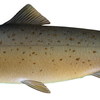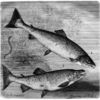Summer Salmon
-
 Atlantic Salmon in Belousikha river, Kola / Ловля семги в реке Белоусиха, Кольский п-ов.
Atlantic Salmon in Belousikha river, Kola / Ловля семги в реке Белоусиха, Кольский п-ов. -
 Клуб Рыболовных Путешествий. На Кольский полуостров за Осенней Семгой
Клуб Рыболовных Путешествий. На Кольский полуостров за Осенней Семгой -
 Ловля семги, Кольский п-ов
Ловля семги, Кольский п-ов -
 Лов семги. Кольский полуостров.
Лов семги. Кольский полуостров.
The summer salmon (Lat. Salmo salar) or as it is otherwise called the Atlantic salmon is one of the most popular and beautiful salmons. This large fish can grow as heavy as 39 kg and as long as 1.5 m. The summer salmon has a wide body, covered with small black spots above the side-line and dense light-silver scales. Although the summer salmon spawns in the rivers, it is in fact a sea fish, living in the Azov, Black and Aral Seas, as well as in nearly all of the North Atlantic Ocean. The summer salmon is very commonly found in Siberian rivers: Lena, Angar, Obi, as well as in the Gulf of Finland, Lake Ladoga and Lake Onega and along the shores of the Arctic Ocean, from the Kola Peninsula in the east to the River Kara. The Pacific summer salmon, which is different from our salmon, is also notable. The presence of summer salmon on the American continent is limited to the Connecticut River in the south and Greenland in the North.
Many of the lakes in the Russian Lapland are named after the “queen of the fish” – salmon. These include, the Semozhnoe Lake in the Ponoya River basin (this lake also had a Lappish name – Niljavr, which means the Arctic Fox Lake); Semzhya River (Salmon River) – the Vykhcyok tributary, which end in Jokang (it also has a Lappish name – Exkyuk, which translates as Annual Lake – probably as the lake rented for a year).
Two of the low islands in the Pory Bay, were probably named after the small salmon, which was fished from June till August. The Luzenga River, was probably rich in summer salmon, because this name means the Salmon River (in the Kildin dialect of Scolt the salmon is called Luss and plural is Luz). Whereas the suffix “enga” is the toponymic formant (formant is the part of the word, which is used to form the words or to change their form).
The summer salmon’s daily diet includes shell-fish and small sea fish, available in the given water body. Near the spawning season the summer salmon loses weight because of not eating. During this time the summer salmon changes to a darker colour and is covered with small red spots on the sides. The males undergo more identifiable changes, whose jaws get long, with the lower jaw curving downwards and the upper one takes the shape of a hook like extension, which falls on the curved end of the lower jaw. Such change in looks is called as “transformation”, therefore adult summer salmon is called the “transformer”.
The summer salmon’s spawning areas are usually at the mouth of the river. So in Europe the summer salmon gethers in the northern part of the Atlantic Ocean, from where it later migrates southwards to Portugal and further to the White Sea, whereas the northern boundary of summer salmon’s habitat is marked by the Kara River.
The Pacific basin houses many types of summer salmon, but they have small populations if accounted for separately. Walter Scott wrote that back in the days there was so much summer salmon that sailors, who were hired for service, especially negotiated the maximum amount of summer salmon in their daily rations. Those old sailors might have loves out time, when various industrial waste, domestic contaminants and of course intensive large scale fishing have made summer salmon not only a delicacy but also another rightful constituent of the Russian and Ukrainian red books. The summer salmon population is decreasing by the year. It is bred in fish farms. The summer salmon’s journey to spawning grounds, just like other salmon species, becomes difficult because of tis late entry into the rivers, which fall end at the Barents and White seas. Its migration starts in August and continues till the first icing. This is the time when the largest of summer salmon enters the rivers. The summer salmon has weak reproductive systems and this does affect their life in harsh subarctic conditions.by the beginning of winter the summer salmon’s migration stops and the fish who could not reach their destinations, pass their winter in areas near the mouth of the river. This summer salmon is also called the “ice cold” fish. The “ice-cold” continues on its journey to the spawning grounds right after the ice breaks and this is usually the end of May. The summer salmon passes around one year in the river, where it does not eat at all and stands still in depressions in pretty cold waters. Only by the next fall it advaces to its spawning grounds. The “ice-cold” is also called the “winter” salmon. The spring salmon or the “opener” salmon goes into the river right behind the “winter” salmon, usually in June.
Following the “closer” salmon the summer salmon enters the river. This salmon is also called the “mean” salmon. This sub-type of salmon has better developed reproductive resources than the abovementioned subtypes and consequently they have more chances of rapid growth and birth of healthy off-springs. The “close” and “mean” salmons are considered as vernal forms of salmon and they spawn in the fall. The smaller salmon (40-50 cm in length and 2.5-3.5kg in weight) are called the “grilse” – these are male salmons of about 1 year of age. About 40-50% of the males of salmon’s subtypes “ice-cold” and “mean” never return to the sea, because they live and grow in the river and under such conditions, even when they are just 10cm long, they grow adult. This is why there is so few of the “ice-cold” and “mean” males in the sea. In some rivers the predominant subtype of summer salmon is the “defoliate”, which resembles the “grisle”, especially as per its small size. This type of fish enters the river together with the fall salmon in the first year of its life in the sea and requires no seasoning, so it spawns the same year. In the Barents and White sea basing the entry of salmon continues for about 5 months and it only stops after the ice sets in.
In western Europe the situation is different. The local salmon, the prototype of our “ice-cold” and fall salmon, for example, enters the River Rhine for spawning in November, the “grisle” goes in July and the “mean” and “closer” go in mid-May. The Norwegian salmon, just like the American salmon goes for spawning during the summer.
Before the construction of the Upper-Tuloma Hep in 1965 the summer salmon from the Gulf of Kola freely elevated together with the passing kumzha (taimen) through the Tuloma River into the Nota Lake and from there it entered various rivers for spawning. Back in those days, it was common to find large size summer salmon in the Nota Lake.
Nowadays, because of the closing of the Upper-Tuloma fish gate and inaction of the local authorities, there is no summer salmon in the reservoir, just like the passing kumzha (taimen). Therefore, fishing enthusiasts can only fish for lake-type kumzha, which can be only as heavy as 5 kg in weight.
Recently the Finnish experts showed readiness to build a new fish gate at the Upper-Tuloma HEP, in the shape of a bypass fish canal. Since many of the tributary rivers start out of Finland, such as Hirvas, Nota, javr, Lotta etc., our neighbours are ready to invest in the construction of the proposed canal: they are ready to invest about 450 thousand Euros only for design and planning and more than 3 million Euros for the construction of the fish gate.
For now we have to await the reaction of our authorities!
Before this becomes a reality, we have time to resolve the problem of pouching!
